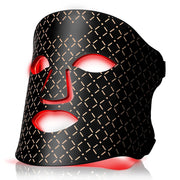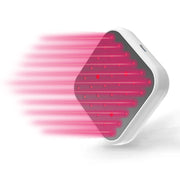Loose skin, along with wrinkles and sunspots, is one of the main reasons people spend money—a lot of money—on skincare products. If you’re interested in a better solution and have wondered whether does red light therapy tighten loose skin?, the answer is yes, it does. And, you’ll get results without the side effects of creams or the expense and risks of plastic surgery.
Just how much money goes to skin health every year? To find that out, the global e-commerce marketplace, Groupon, conducted a survey of 2,000 American men and women. The survey revealed that the average person spends about $600 per year on moisturizers and anti-aging skin care products.
When people buy anti-aging products for the face, it is typically because they want to minimize the appearance of fine lines and wrinkles, and firm up sagging skin. In terms of the latter, the results are often disappointing. Most products that claim to result in firmer skin are only partially effective or have fleeting results. But before we get into what works and what doesn’t, we’ll discuss why skin loses elasticity in the first place.
In this post, we’ll cover why skin starts to droop, solutions that work and don’t work, and how red light therapy for skin tightening can be the answer to more youthful skin.
Causes of Loose Skin
Sagging skin can appear anywhere on the body, with the face and neck, back of the upper arm (tricep), and abdomen being the most typical areas.
The most common cause of sagging skin, says dermatologist Eric Seiger, is simply aging. “As you age, your skin begins to lose its natural elastin and collagen,” he says. Healthy collagen development is one of the primary contributors to plump, youthful skin, so as this production slows down with age, connective tissue becomes weaker and skin looks more tired.”
This is also one main cause of fine lines and wrinkles, whereby the skin is “taught” to stretch in a certain way according to someone’s dominant facial expressions. But due to age-related collagen depletion, the skin doesn’t bounce back as quickly, which leads to the formation of wrinkles.

Other potential causes of loose skin include:
- Sudden and dramatic weight loss;
- Pregnancy, including postpartum weight loss and hormonal changes;
- Loss of muscle mass, with effects particularly noticeable on the face/neck, and upper arms;
- Heredity: Caucasians tend to develop earlier signs of photoaging than other populations, according to a 2016 study published in the Journal of Clinical and Aesthetic Dermatology;
- Sun exposure: French researchers confirmed that UV exposure appears to be responsible for 80 percent of visible facial aging, including sagging skin;
- Diet: According to researchers at Dartmouth Medical School diets high in sugar damage collagen fibers and prevent them from repairing themselves;
- Smoking, heavy drinking, and other detrimental lifestyle choices;
- Illness or disease;
- Chronic dehydration.
How Does Red Light Therapy Tighten Loose Skin?
Red light therapy, also known as low-level light therapy (LLLT) or photobiomodulation (PBM), is a popular and highly effective therapeutic treatment. It is used to reduce the signs of aging (including fine lines and wrinkles and age spots), promote wound healing, treat chronic skin conditions, and reduce the appearance of scars, among dozens of other uses.
Red light therapy uses wavelengths of red light that range in length from 630 to 660 nanometers (nm), and near-infrared (NIR) light that ranges from 810nm to 850nm. These wavelengths stimulate beneficial processes at the cellular level—healing from the inside out. That’s why red light therapy is so effective at restoring healthy skin tone and reversing other signs of aging. Here’s how red light can tighten sagging skin.
Increased Cellular Energy
The human body is made up of trillions of cells, all with their own structures and functions. The performance of individual cells directly affects the whole, and restoring normal cellular functioning is the only way to restore optimal health—which includes reversing sagging skin and restoring its firmness and elasticity.
When you wake up tired after a lack of sleep, you can’t perform at your best. The same is true of your cells. When they are low on energy, it is referred to as mitochondrial dysfunction: a condition in which the “energy factories” within cells (known as mitochondria) are not producing enough “power” and the cells can’t do much more than focus on survival.
Mitochondrial dysfunction can have many causes including chronic inflammation or oxidative stress. Fortunately, red light therapy can reverse this dysfunction and bring your cells’ energy production back to normal.
When red light shines onto your skin, it absorbs into the tissues where it interacts with light-sensitive chromophores in each cell. This interaction stimulates mitochondria to produce adenosine triphosphate (ATP), which is the body’s primary energy source. Whether energy is metabolized through food or light, it ultimately ends up as ATP.
A boost in energy will help cells perform their normal specialized functions, as well as repair and regenerate, at full capacity.
Increased Collagen and Elastin Production
While the entire body can and does benefit from improved cellular energy production, there are a few cells that are particularly responsive to red light.
According to a 2008 research review by Joseph Tafur and Paul Mills of the University of California at San Diego, these cells include:
- Fibroblasts (the cells responsible for collagen synthesis)
- Epithelial cells (the stretchy cells on the surface of the skin; acting as the barrier between you and the environment)

In short, red light therapy is extremely helpful for your skin cells, especially the cells that produce collagen and keep your skin firm and smooth.
Collagen, a protein that makes up about 80 percent of the skin, provides the structure for skin, which is what keeps it feeling firm. Elastin is the protein that makes skin stretch and bounce back. Without these key proteins, the skin has no support and no elasticity.
The key to restoring firmness and elasticity is to stimulate healthy collagen production that will support the skin, much like the springs in a mattress support someone’s weight.
Improved Circulation
Good skin tone also relies on good blood and lymph circulation to the skin. Blood flow brings nutrients to the skin, and lymph removes waste from the skin, reducing oxidative stress and the presence of cell-damaging pathogens.
Endothelial cells, which make up the inner layer of capillaries, are present both in the cardiovascular system and the lymphatic system. A 2017 study by researchers from Austria found that red light therapy promotes the growth of endothelial cells to improve circulation.









